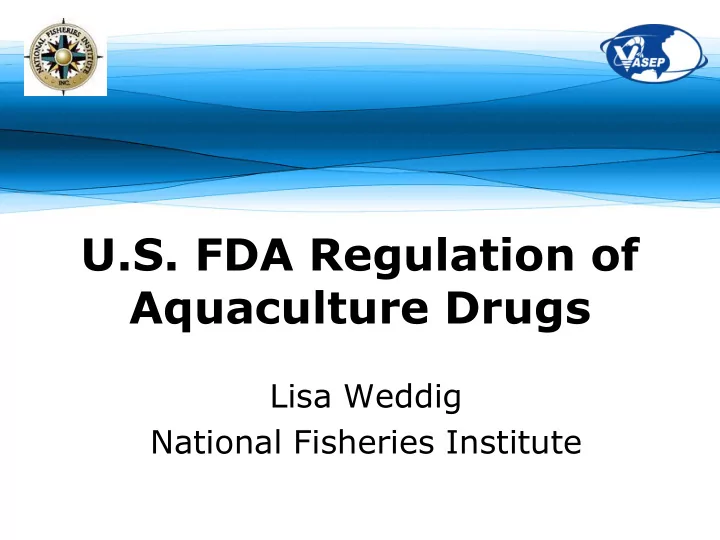

Washington DC | New York | Denver | Seattle U.S. FDA Regulation of Aquaculture Drugs Lisa Weddig National Fisheries Institute
Who is NFI? • Leading advocacy organization in the U.S. for the seafood industry. • NFI’s members represent every element of the industry • fishing vessels • processors • importers • restaurant and retail chains • suppliers to the industry • NFI and members support and promote sound public policy based on science.
Agenda • Why antibiotics in aquaculture seafood a concern for U.S. Importers • U.S. FDA Regulations for the use of aquaculture drugs • U.S. FDA regulatory compliance and inspection programs • Questions about product testing • HACCP Controls for aquaculture drugs • Challenges (discussion with all) • Questions and Answers
Washington DC | New York | Denver | Seattle Antibiotics Why a concern?
Top Ten Species - 2013 Shrimp 3.60 Pangasius 0.771 Salmon 2.702 Cod 0.605 Canned Tuna 2.30 Catfish 0.566 Tilapia 1.43 Crab 0.548 Pollock 1.154 Clams 0.352 U.S. Per capita consumption is 14.5 pounds (less than 4.5 ounces per week) Source: National Fisheries Institute at www.aboutseafood.com
Encouraged to Eat More • 2010 Dietary Guidelines for Americans (www.dietaryguidelines.gov) • Twice a week make seafood the main protein food on your plate . • Eating about 8 ounces per week of a variety of seafood can help prevent heart disease
Source of Seafood
Center For Disease Control Analysis of Reported Illnesses from Food 2005-2010 100,000 reported illness from all food sources 141 illnesses reported from 2,348 illnesses imported seafood reported from (0.141% of total) all imported food (2.4% of total) None of the fish identified as causing illnesses were from farmed sources.
“While US fisheries are very strictly managed, I am not confident that the same level of management is upheld for global fisheries .” “While there are certainly standards in place as you pointed out, to my knowledge they are not necessarily enforced. For example, while not allowed in the US, shrimp in many foreign farms are given daily doses of antibiotics which we know can lead to antibiotic resistant disease .” “… over 90% of the shrimp in the US is imported and less than 2% is inspected by the FDA is sufficient reason for me to personally avoid consuming this particular type of seafood …”
“While US fisheries are very strictly managed, I am not confident that the same level of management is upheld for global fisheries .” “While there are certainly standards in place as you pointed out, to my knowledge they are not necessarily enforced. For example, while not allowed in the US, shrimp in many foreign farms are given daily doses of antibiotics which we know can lead to antibiotic resistant disease .” “… over 90% of the shrimp in the US is imported and less than 2% is inspected by the FDA is sufficient reason for me to personally avoid consuming this particular type of seafood …”
Why a Concern?
Vietnam 700 600 500 400 300 200 100 0 2008 2009 2010 2011 2012 2013 2014 Additives Administrative Chemical Contaminant Decomposition/Filth/Insanitary Drugs/Residues Economic Integrity Heavy Metals Histamines Labeling Mercury Natural Toxins Packaging Parasites Pathogens Undeclared Allergens Other
Why a Concern?
2014 Findings • Australia • Ciprofloxacin • Enrofloxacin • Furazolidone • Leuco-Malachite Green • Malachite Green • Nitrofurazone
2014 Findings • chlorpyriphos • European Union • trifluralin • doxycycline • chloramphenicol • nitrofuran (metabolite) furazolidone (AOZ) • nitrofuran (metabolite) nitrofurazone (SEM) • doxycycline • oxytetracycline • sulfadiazine • sulfonamide • tetracycline • trimethoprim • ciprofloxacin • oxytetracycline • sulfonamide • trimethoprim • leucomalachite green • malachite green • permethrin
2014 Findings • AMPHENICOLS • Canada • AVERMECTINS • FLUOROQUINOLONES • NITROFURANS • QUINOLONES • SULFONAMIDES • TETRACYCLINES • TRIPHENYLMETHANE DYES (MG & GENTIAN VIOLET)
2014 Findings • paclobutrazol • Japan • chlorpyrifos • prometryn • chloramphenicol • chlortetracycline • dieldrin • enrofloxacin • furazolidone (as AOZ) • furazolidone • Leucomalachite green • oxytetracycline • sulfamethoxazole • aldrin • chlordane
Washington DC | New York | Denver | Seattle FDA Regulations
Scope of CVM • Center for Veterinary Medicine (CVM) protects both animal health and human health • FDA-CVM regulates: • Animal Drugs • Animal Feed (which includes pet food) • Veterinary Devices • FDA-CVM does not regulate: • the practice of veterinary medicine • vaccines for animals.
CVM Activities • New Animal Drug Review • Animal Generic Drug Review • Post-approval monitoring (surveillance) of animal drugs. • Protection and Safety of Animal Feed • Compliance actions • Research to support regulatory decision-making
FDA Approved Aquaculture Drugs Drug Approved Species Chorionic gonadotropin Brood finfish Formalin Finfish Finfish eggs Penaeid shrimp Salmon, trout, catfish, largemouth bass and bluegill Florfenicol Channel catfish salmonids Tricaine methanesulfonate Families: Ictaluridae, Salmonidae, Esocidae and Percidae Oxytetracycline dihydrate Catfish, salmonids, lobster Oxytetracycline hydrochloride Finfish fry and fingerlings Hydrogen peroxide Fishfish eggs Salmonids Freshwater-reared coolwater finfish Channel catfish Sulfamerazine Trout (rainbow, brook, brown) Sulfadimethoxine/ormetoprim Catfish Salmonids (trout and salmon) Chloramine-T freshwater-reared salmonids walleye, freshwater-reared warm water finfish
Recommend
More recommend